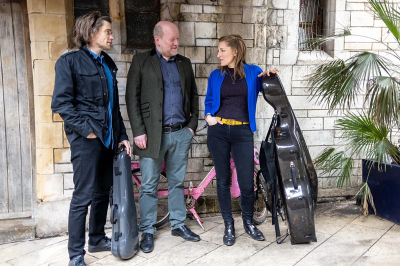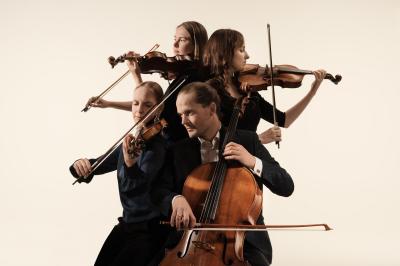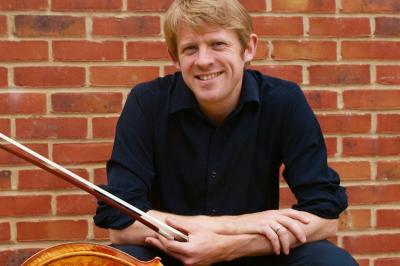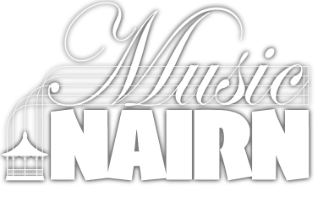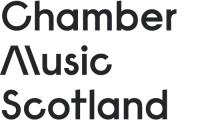Maximiliano Martin Clarinet Trio
Maximiliano Martin, clarinet
Philip Higham, cello
Julian Milford, piano
We look forward enthusiastically to the return to Nairn of Spanish clarinettist Maximiliano Martin, who has performed as a soloist and chamber musician in many of the world's most prestigious venues and at international festivals, including the BBC Proms and at Wigmore Hall in London. Maxi is Principal Clarinet of the Scottish Chamber Orchestra and is in constant demand as a soloist, chamber musician and teacher. He and SCO principal cello Philip Higham, both established internationally acclaimed soloists in their own right, are joined by London Conchord Ensemble pianist Julian Milford in three major works for clarinet, cello and piano.
Maximilliano Martin (clarinet)
Born in Tenerife, Maxi studied in Tenerife, Barcelona and at the Royal College of Music in London where he graduated with distinction. Principal Clarinet of the Scottish Chamber Orchestra, Maxi has a busy international career and is in constant demand as a soloist, chamber musician and teacher. As a concerto soloist he has performed with, among others, the Scottish Chamber Orchestra and the European Union Chamber Orchestra, and as a chamber musician is a member of the London Conchord Ensemble and SCO winds. His many acclaimed recordings include the Brahms Sonatas with Julian Milford, and Brahms Quintet with the Badke String Quartet.
Philip Higham (cello)
Edinburgh born Philip studied at St Mary's Music School and the RNCM with Emma Ferrand and Ralph Kirshbaum. In 2008 he became the first UK cellist to win 1st prize at the International Bach Competition in Leipzig. He is now principal cello with the Scottish Chamber Orchestra, and also pursues a busy solo and chamber career, appearing frequently at the Wigmore Hall (including a notable performance of the Bach Cello Suites) and as concerto soloist with some of the UK's top orchestras. Philip plays a cello by Carlo Giuseppe Testore, made in 1697.
Julian Milford (piano)
After a degree in English Literature at Oxford, Julian studied piano at the Curtis Institute and Guildhall, becoming a professional pianist specialising in chamber music. Another career move saw him become an eminent barrister, but he cherishes his music career, being a founder member of the London Conchord Ensemble and appearing as duo partner with top musicians such as Thomas Allen, Christopher Maltman and Sarah Connolly.
Programme Notes:
Faure Clarinet Trio Op 120 in D minor (1923)
Allegro ma non troppo
Andantino
Allegro Vivo
Faure wrote this work in 1923 towards the end of his life, after retiring from Directorship of the Paris Conservatoire. Unfortunately by this time he was suffering from increasing deafness and fatigue, but there is no trace of his troubles in this serene work. He bridges the transition between classical forms and the developing impressionism of his pupil Ravel and Debussy, still adhering to known forms, but letting themes flow into and develop upon each other, often based on Gregorian modal entities. This work shows Fauré at the height of his melodic powers, the richness of his expanded harmonic palette heightening the dramatic development of the beautiful melodies that infuse the piece throughout.
Zemlinsky Clarinet Trio Op 3 in D minor (1896)
Allegro ma non troppo
Andante
Allegro
Alexander von Zemlinsky was born in Vienna and taught orchestration, his many eminent pupils including Schoenberg, Berg, Webern, Korngold and Alma Mahler. However he was never won over to the New Vienna School's atonalism, and rather looked to Brahms for his inspiration for the Clarinet Trio. He was an acclaimed conductor, but the Anschluss forced Zemlinsky to emigrate to New York, where in 1939 he suffered a stroke and died three years later. The Clarinet Trio of 1896 shows the influence of Brahms both in its form and its content, but with added fin-de-siècle energy, contrasting the brooding intensity of the opening theme with a lighter and calmer motif. The three instruments weave around each other in the beautifully rhapsodic Andante, while the last movement's energetic rondo is briefly interrupted by memories of the previous movements before coming to a cheerful close.
Beethoven Clarinet Trio Op 38.
Adagio-allegro: Adagio Cantabile: Tempo di Menuetto: Tema con Variazioni : Scherzo : Andante con moto alla marcia.
Beethoven's Op 20 septet, written in 1799 did much to launch his career, and its popularity led him to create his own arrangement of the work for Clarinet Trio. Op 38. This version of the work maintains the fresh, innovative character of the original septet. From the spacious elegance of the adagio introduction to the first movement, leading with energy, expression and momentum into the allegro con brio, we are on a very similar musical journey to the septet itself. The slow movement, adagio cantabile, is a wonderfully melodic vehicle for the clarinet's lyrical qualities, while the minuet and trio is every bit as characterful. The following theme and variations highlights lots of imaginative interplay between the three instruments, while the scherzo brims with energy and excitement. After a dark introduction, the final movement leads into the vibrant, energetic presto.
Programme
| Faure | Clarinet Trio in D minor, Op. 120 |
| Zemlinsky | Clarinet Trio in D minor, Op. 3 |
| Beethoven | Clarinet Trio in Eb major, Op. 38 |
Venue & Arrangements
Forthcoming Events
